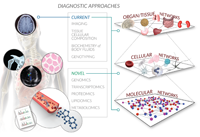Autoregulation of Biological Networks
BrSM embraces a holistic image of the human body as a multi-scale, multi-level regulatory network of molecules, cells and tissues. Autoregulation is an inherent feature of regulatory networks. At the biochemical level, at least three types of molecular networks (metabolite, protein, and gene) are interconnected to create a global biochemical network. The feedback loops across these networks provide the basis for autoregulation of the global, organism-wide molecular network. It is postulated that there is a high level of molecular coherence in healthy tissues. Loss of molecular order corrupts "healthy" information flow in the tissue. Sustained corruption of "healthy" information flow leads to the failure of regulatory networks to restore molecular coherence.
A fundamental feature of autoregulatory networks is robustness. Robustness is the ability to maintain homeostasis in the face of perturbations and uncertainty. Robust networks can autoregulate to restore or adapt their functional state in response to perturbations. The human organism is continuously challenged by genetic, epigenetic and environmental perturbations that “distort” biological networks. Persistent perturbation of biological networks can manifest as disease.
Many diseases are interconnected by shared pathophysiological events. Researchers recently have identified a common network referred to as a “common disease-state signature” that is perturbed in many diseases. This common denominator network might be an access point for treating several co-morbidities. A “common disease-state signature” supports the development of medications that target biological networks instead of single molecules.

Multi-scale autoregulatory networks.
Bioregulatory Systems Medicine encompasses a systems biology perspective of interactions within and across multiple levels of biological organization. The complexity of a systems approach challenges common paradigms, and paves the way for medicine that works with rather than against the inherent interconnectivity of biological organization. From the molecular to the cellular to the organ to the whole organism network, the BrSM model acknowledges that human health and disease are driven by the regulatory information flow that propagates throughout this global autoregulatory network. Current diagnostic approaches are limited by capturing only a static snapshot of some of this information. Novel diagnostic approaches will not only confirm and provide higher resolution of existing clinical information, but will also expand its scope by adding novel (surrogate) biomarkers of autoregulatory capacity in one spatiotemporal model specific to the patient.
